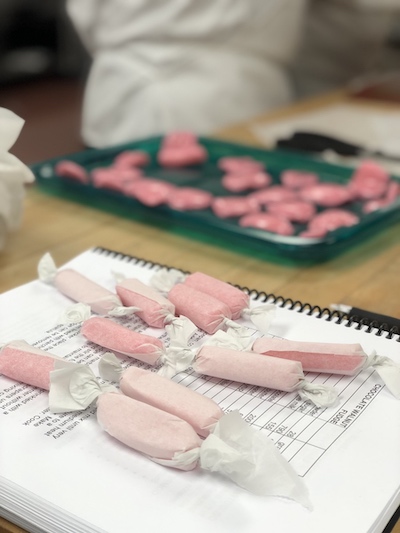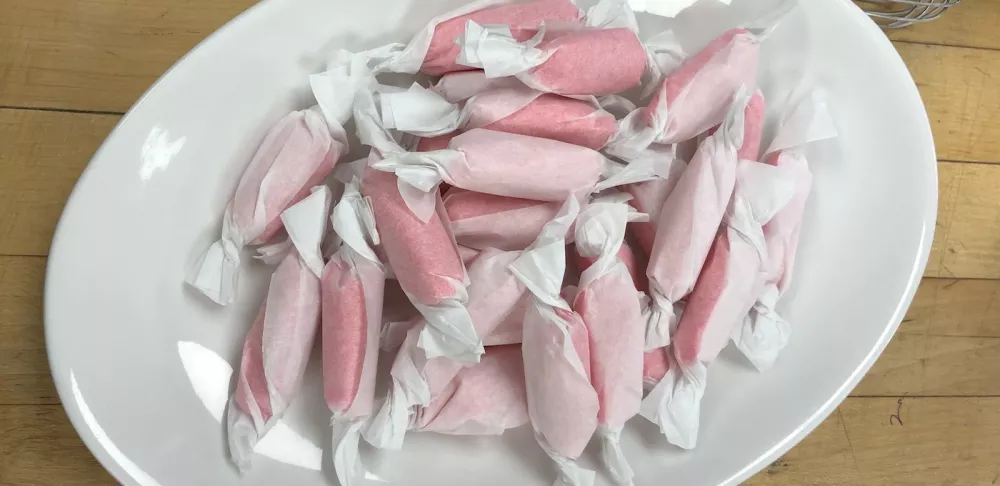Saltwater taffy originated on the East Coast in Atlantic City, New Jersey. While the beach community is credited with the candy's origin, there is some debate as to when and why it was made with briny water. A widely believed account is that a big storm hit Atlantic City in 1883, which caused the ocean water to surge into a local candy store, soaking a stash of taffy. The shop rebranded the batch with the name “saltwater taffy,” which was trademarked in 1923, and the iconic beach town treat is now prevalent in summer destinations on both coasts.
Growing up, Pastry & Baking Arts Chef-Instructor Stephen Chavez and his family would take a perennial summer pilgrimage to Catalina Island, about 20 miles off the Southern California coast. “Dead center in the middle of town was Lloyd’s Candy Shop,” Chef Chavez says. “The ferry would dock and I would walk right up the pier and straight into Lloyd’s.”
Chef Stephen says the main draw of Lloyd’s was the mesmerizing taffy machine staged in the shop’s front window, pulling taffy since 1941. Now his students get to learn how to make taffy during the candy module of ICE's Pastry & Baking Arts program.
 “Candy making is a really specific part of the baking world,” Chef Stephen says. “It’s different than anything else and the students are always excited to do it.” In addition to being enjoyable and tugging at those childhood memories, the lesson on taffy builds on sugar coursework. “When we cover candy making, we are talking about different levels of sugar work, taking things from caramel, the highest temperature, down to a lower one for taffy."
“Candy making is a really specific part of the baking world,” Chef Stephen says. “It’s different than anything else and the students are always excited to do it.” In addition to being enjoyable and tugging at those childhood memories, the lesson on taffy builds on sugar coursework. “When we cover candy making, we are talking about different levels of sugar work, taking things from caramel, the highest temperature, down to a lower one for taffy."
Students also study marshmallows, brittle and lollipops in this module. Making taffy requires proper temperature, texture, coloring and flavoring to ensure a good final product.
“It is really important to hit 252 degrees Fahrenheit when making taffy,” Chef Stephen explains. “At that precise point is when you add flavor and color, before pouring the mixture onto a table.” It's necessary because the color tends to fade as the taffy is worked and stretched. He recommends using concentrated flavor oils.
The work surface also has a direct impact on the outcome of taffy. “You don’t want to pour the taffy onto a metal table because it can bow or pop,” Chef Stephen says, warning against a wood surface as well as it tends to maintain heat and delay the cooling process.
“In the old days, they would pour taffy onto a buttered surface like marble,” Chef Stephen says. “They would also have taffy pulling parties, where they would butter their hands — it was part of courtship — and everyone would join in pulling taffy by hand.” Chef Stephen’s students pour the hot taffy mixture onto Silpat on top of marble surfaces. The silicon provides low thermal resistance and is non-stick, while the marble helps the cooling process. Rather than grease up their hands, students wear gloves.
“It’s very hot when it is first poured, so you have to wait until it settles,” Chef Stephen says. Once the taffy is cool enough to handle, Chef Stephen’s students start pulling, stretching and twisting.
“The goal is to get rid of the clearness and work it until it becomes opaque, chewy and pliable,” Chef Stephen says. “It should not be so soft it sticks or so hard that it breaks your teeth.” Once the consistency and color are correct, students roll their taffy into a long log and cut it into pieces by hand. Afterward, they wrap each piece in parchment or wax paper.
As students get the hang of the texture, Chef Stephen says taffy pulling by hand is fairly simple. However, he recommends following a few rules of thumb: First, make sure to use a thermometer that goes up to 252˚F, such as a candy thermometer. Second, use regular granulated, cane sugar. Last, have fun with flavor and color combinations. “You can flavor them in any way!,” Chef Stephen says. “There’s chicken and waffles, s’mores or maple-bacon. You can do multiple colors, swirl together or stack colors like candy corn. You can play around with it. It is super fun to see how sugar evolves into taffy and the magic that that brings.”

Here is our saltwater taffy recipe:

Ingredients
- 200 grams sugar
- 9 grams cornstarch
- 225 grams light corn syrup
- 22 grams butter
- 115 grams water
- 6 grams salt
- 2.5 grams vanilla
- 2 to 8 grams flavored candy oil
Directions
- Mix the sugar and cornstarch together in a small pan. Stir in the light corn syrup, butter, water and salt. Cook over medium heat, without stirring to 252 F while occasionally washing down the sides of the pan with water.
- When the mixture reaches 252 F, remove the pot from the heat and stir in the vanilla and candy oil. Pour the mixture onto a Silpat on marble.
- After a few minutes, utilizing a sprayed bench scraper or spatula, bring the outside of the taffy in toward the center continuously to cool the taffy evenly.
- When the taffy is cool enough to handle, about 5 minutes, pull and fold the taffy continuously to aerate and cool.
- Once shiny and cool enough to hold its shape, roll into thin or twisted cylinders and cut with a sprayed scissor into desired size pieces. Wrap in candy wrappers for storage.
Make candy, cake, cookies and more with Pastry & Baking Arts career training at ICE.




